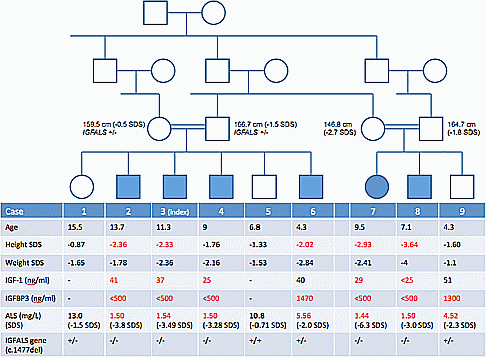ESPE2016 Poster Presentations Growth P1 (48 abstracts)
IGFALS Gene Deletion in a Family with Short Stature
Belma Haliloglu a , Monique Losekoot b , Avni Kaya a & Jan-Marteen Wit b
aPediatric Endocrinology Department, Diyarbakir Child Health Hospital, Diyarbakir, Turkey; bPediatric Endocrinology and Growth Department, Leiden University Medical Center, Leiden, The Netherlands
Background: ALS deficiency is characterized by mild short stature, delayed puberty, low serum IGF1, low serum IGFBP3 and undetectable serum ALS levels.
Case: A 11.3 years old boy presented with short stature. He was born at term to consanguineous parents and the birth weight was unknown. On physical examination, his height and weight were 130.5 cm (−2.33 SDS) and 25.2 kg (−2.36 SDS) and he was prepubertal. The routine laboratory tests were normal, IGF1 level was very low and bone age was delayed (9 years). Since peak GH level in clonidine test was 10.3, IGF generation test was performed and unresponsive to GH (before IGF1:37,IGFBP3:<500, after IGF1:39,IGFBP3:<500). In light of this information, ALS deficiency was thought and the family members were checked (Figure). The short siblings had low IGF1-IGFBP3 levels. IGFALS gene analysis identified a homozygous c.1477del (p.Arg493fs) deletion in the index case and short siblings. Also, his short cousins were checked and they had same deletion in IGFALS gene.
Conclusion: Since, patients with ALS deficiency have mild short stature and heterozygous parents have low-normal height, these patients can be diagnosed as familial short stature. Therefore, the physician should be careful at differential diagnosis of short stature.

 }
}



